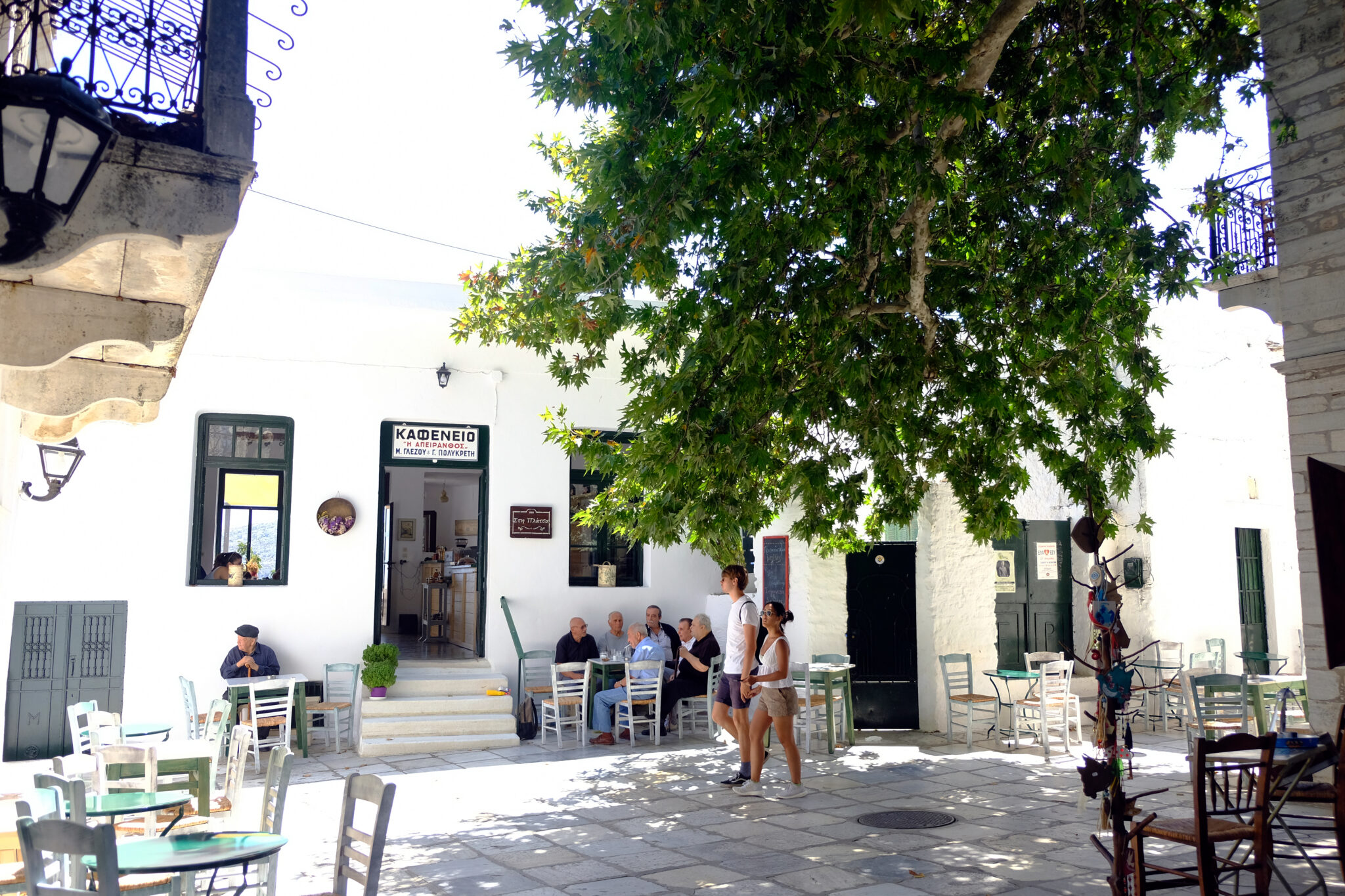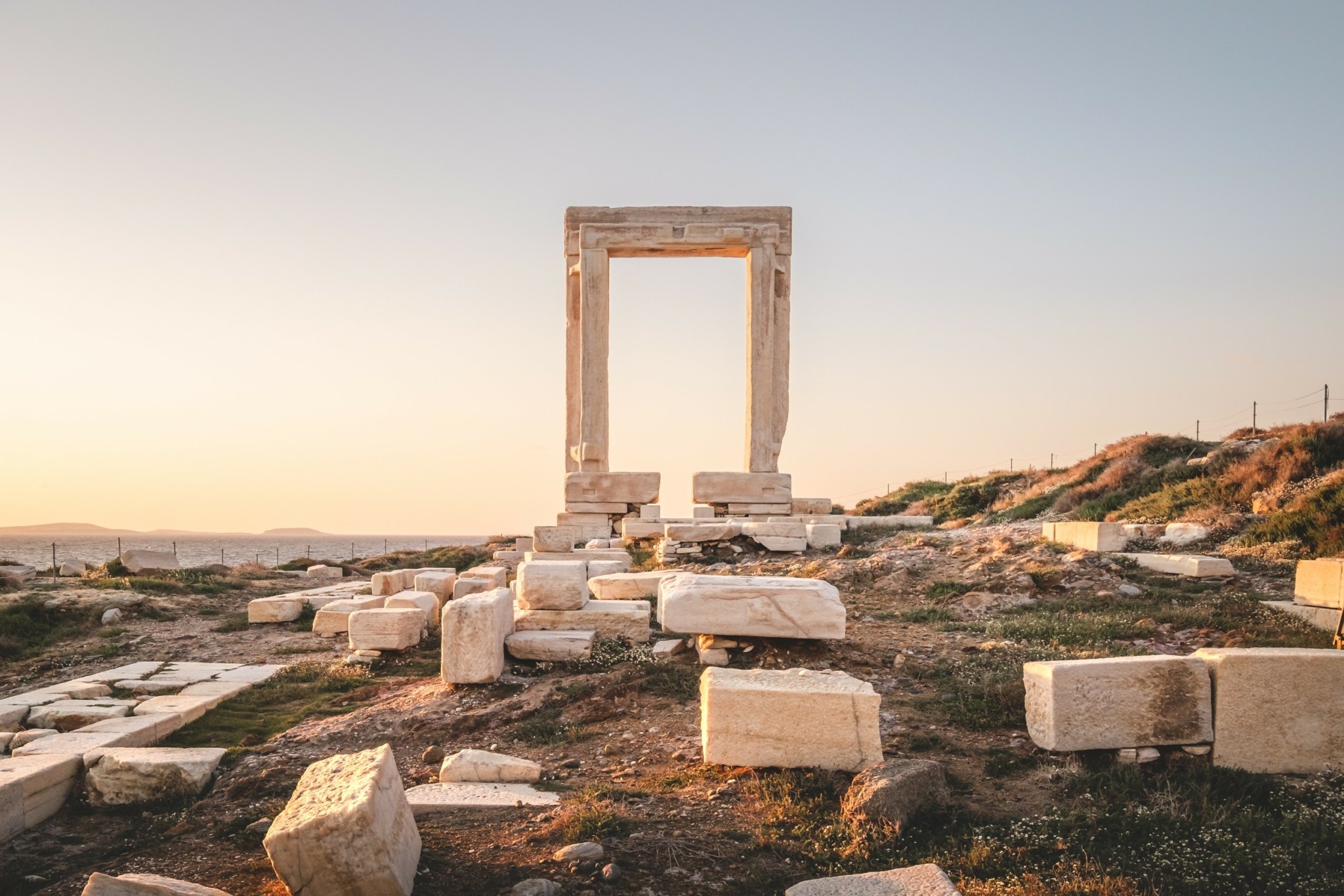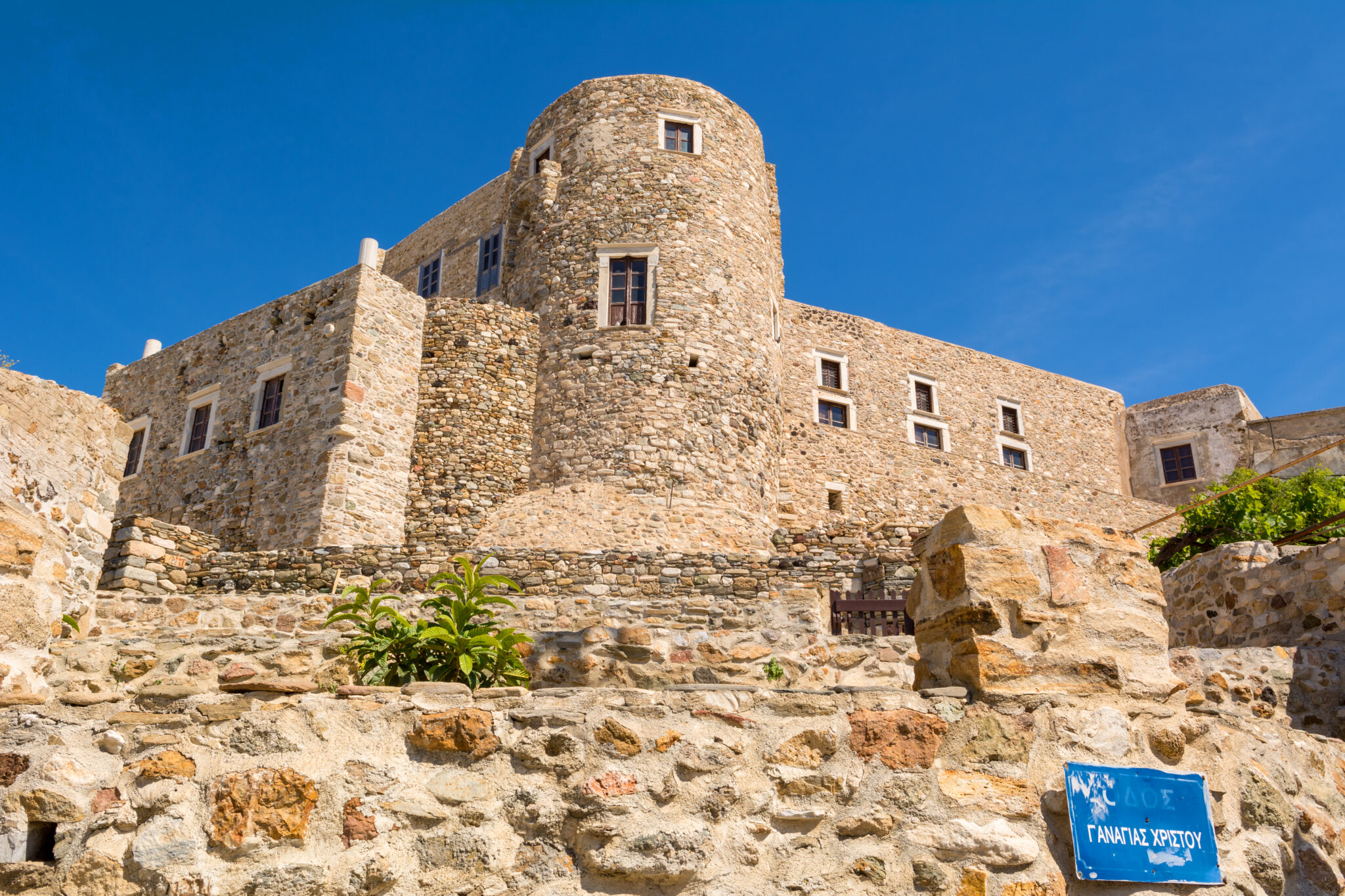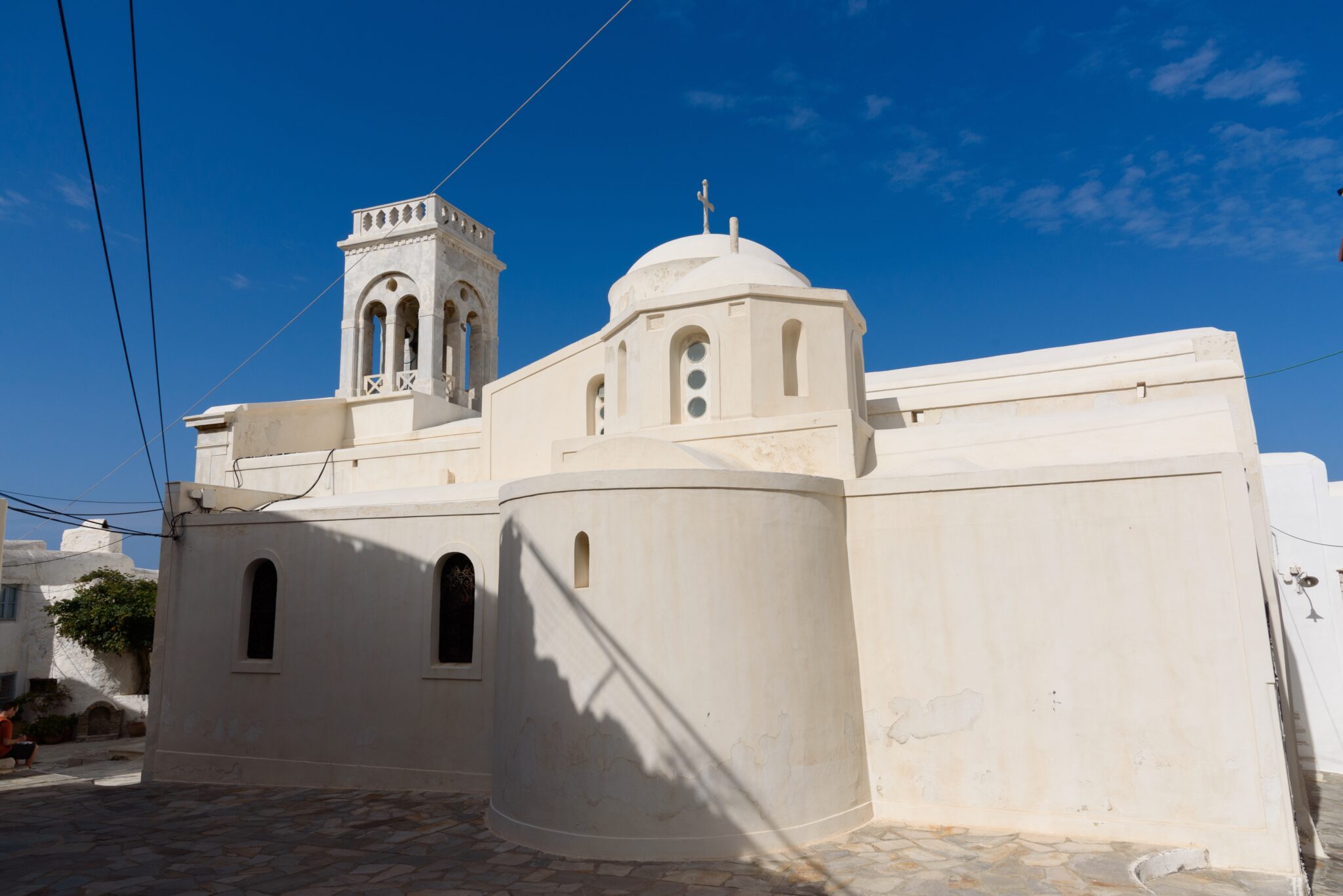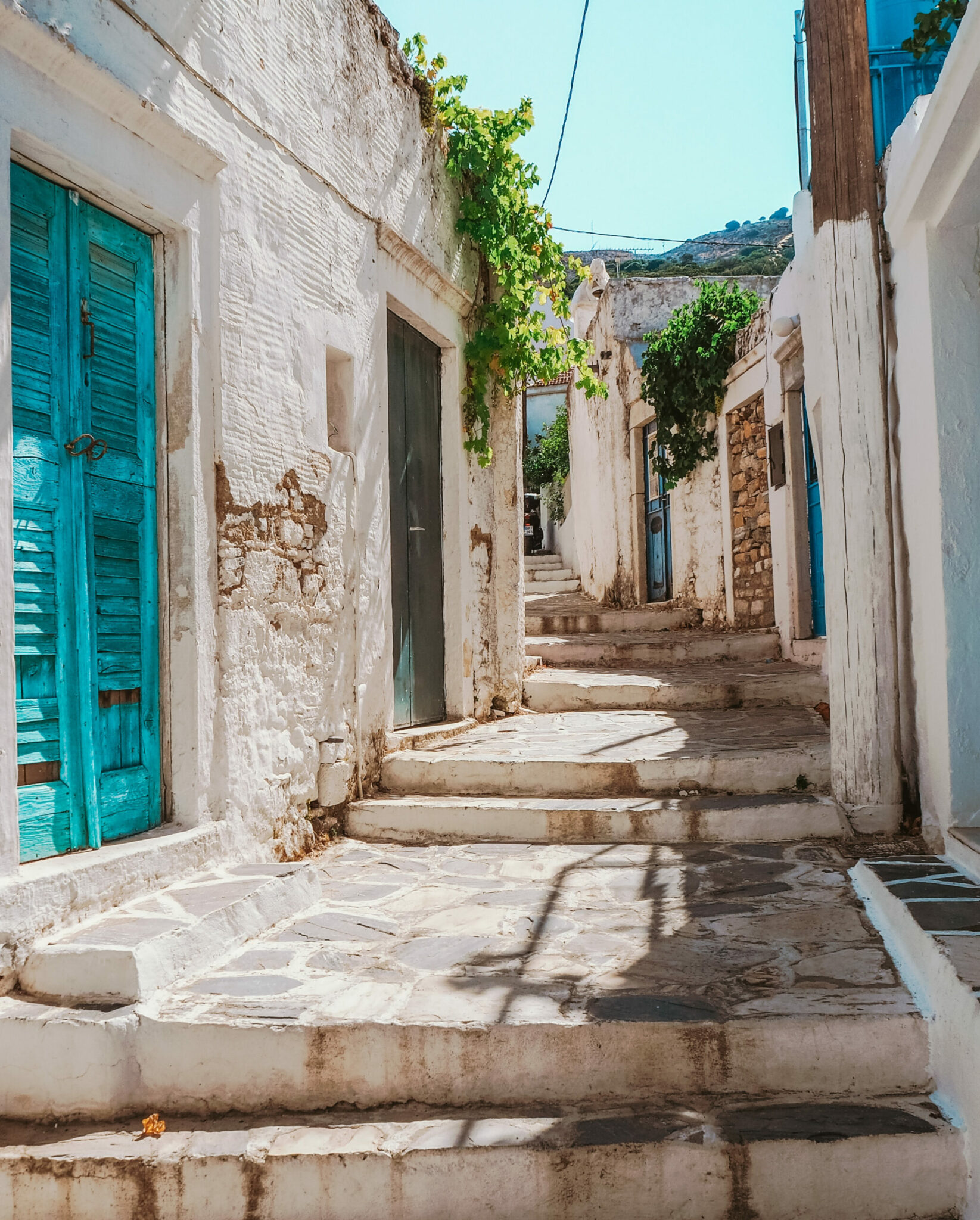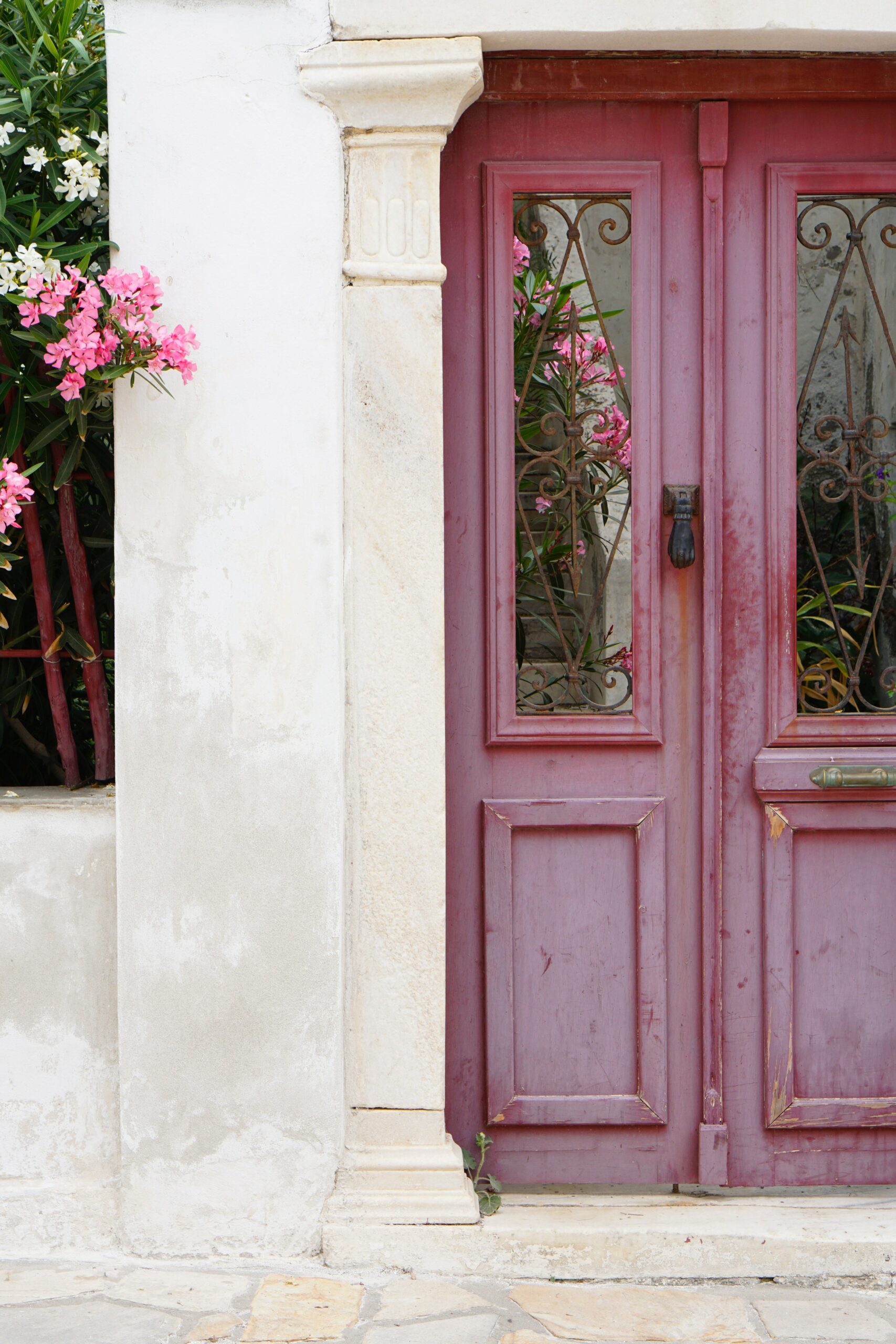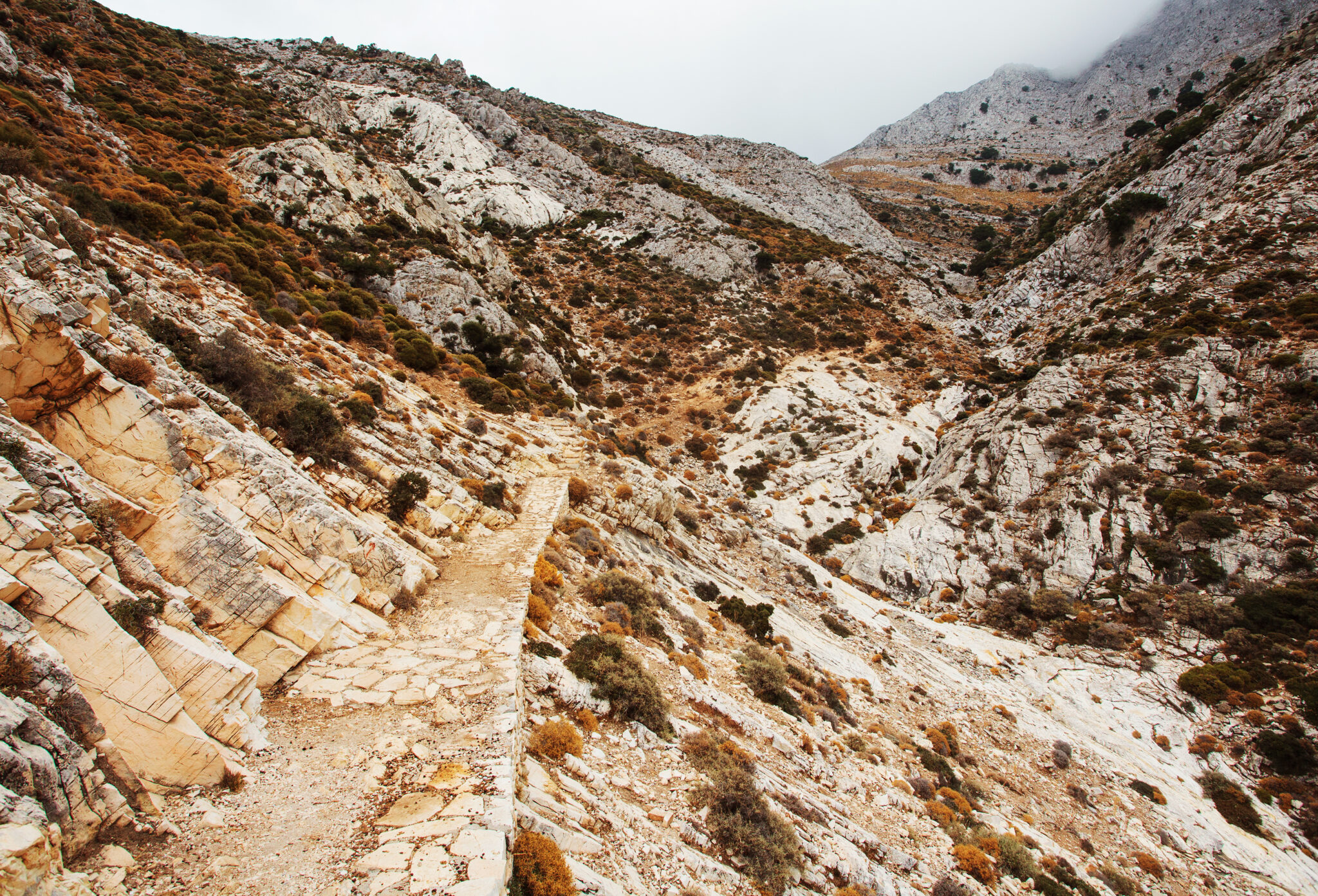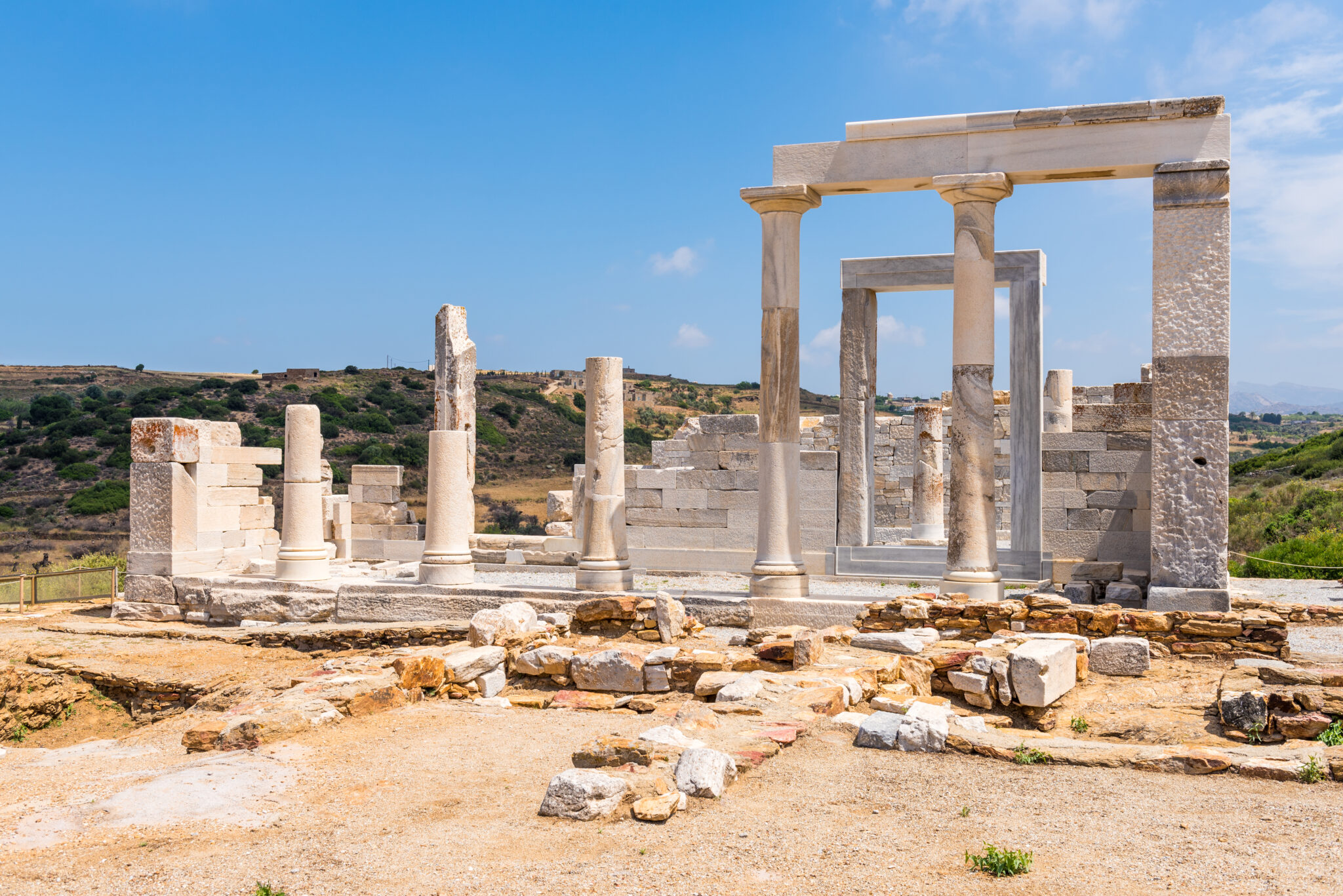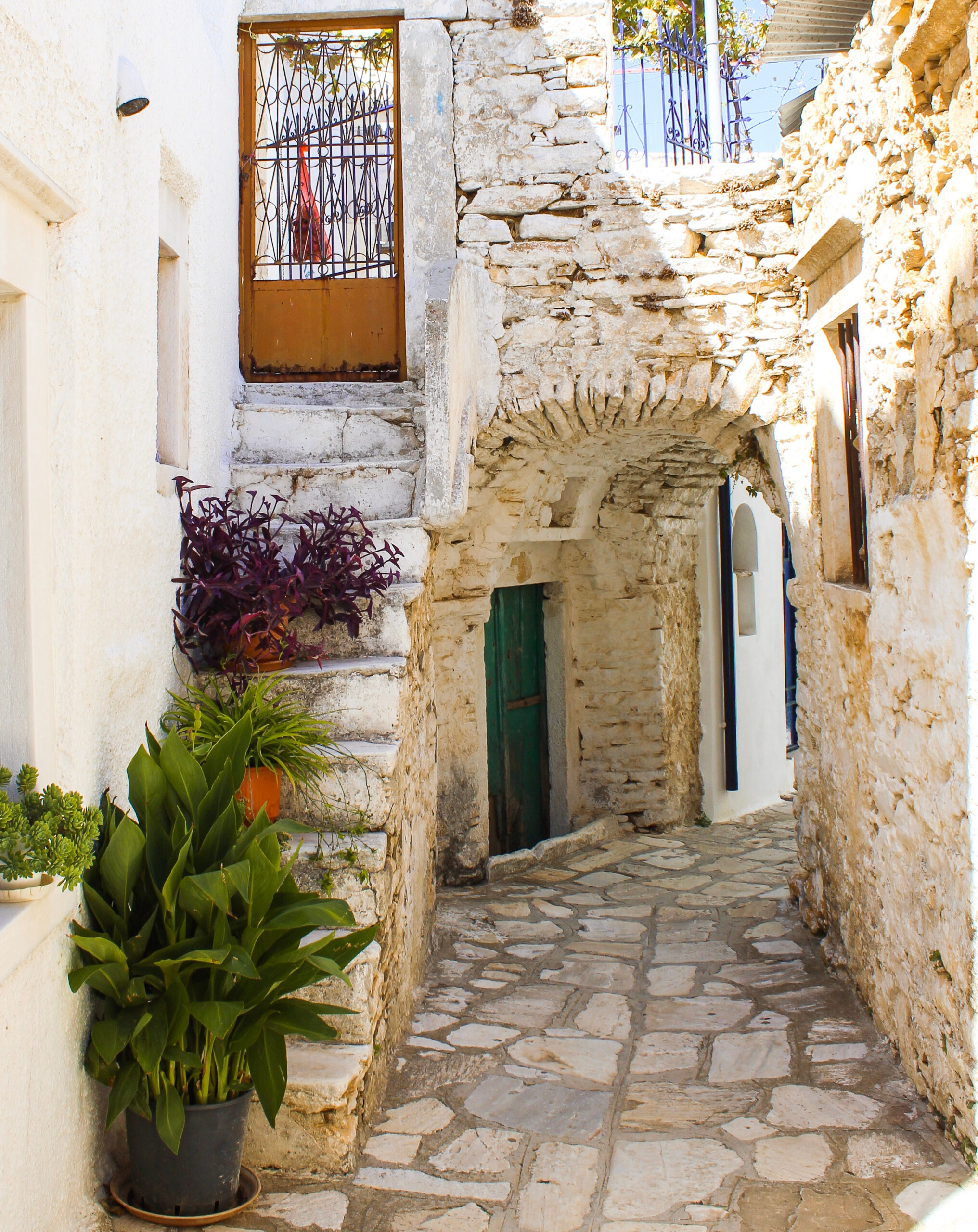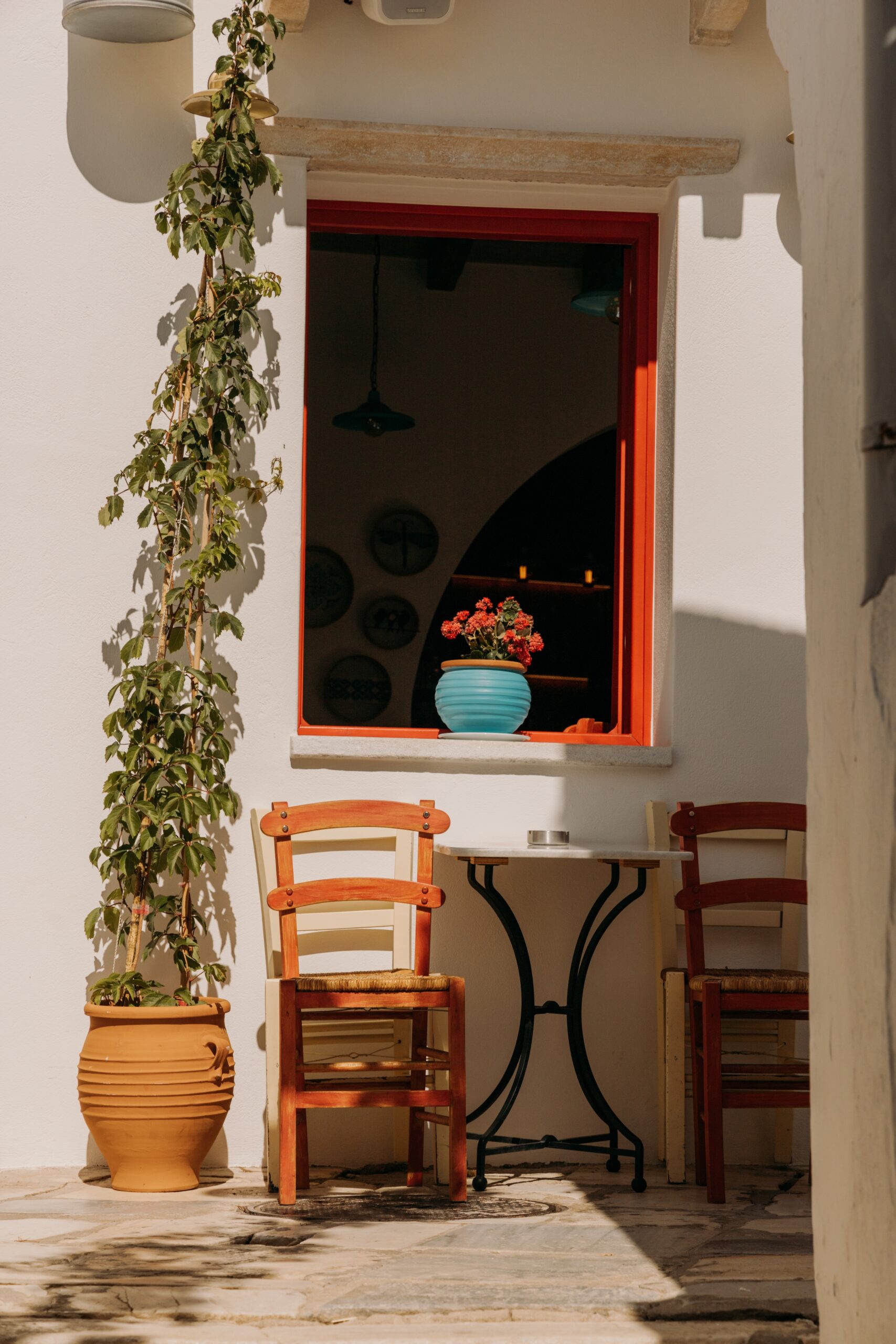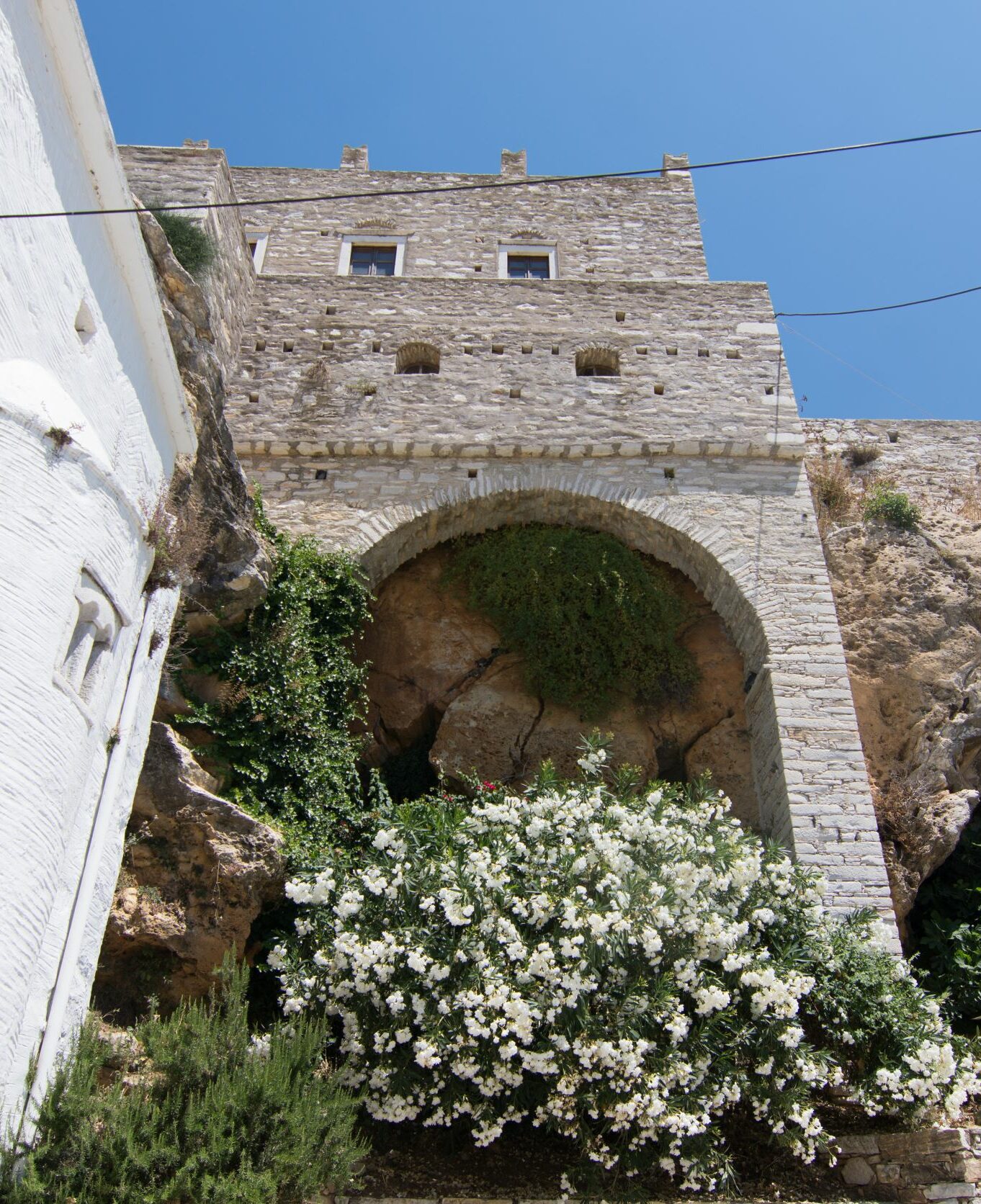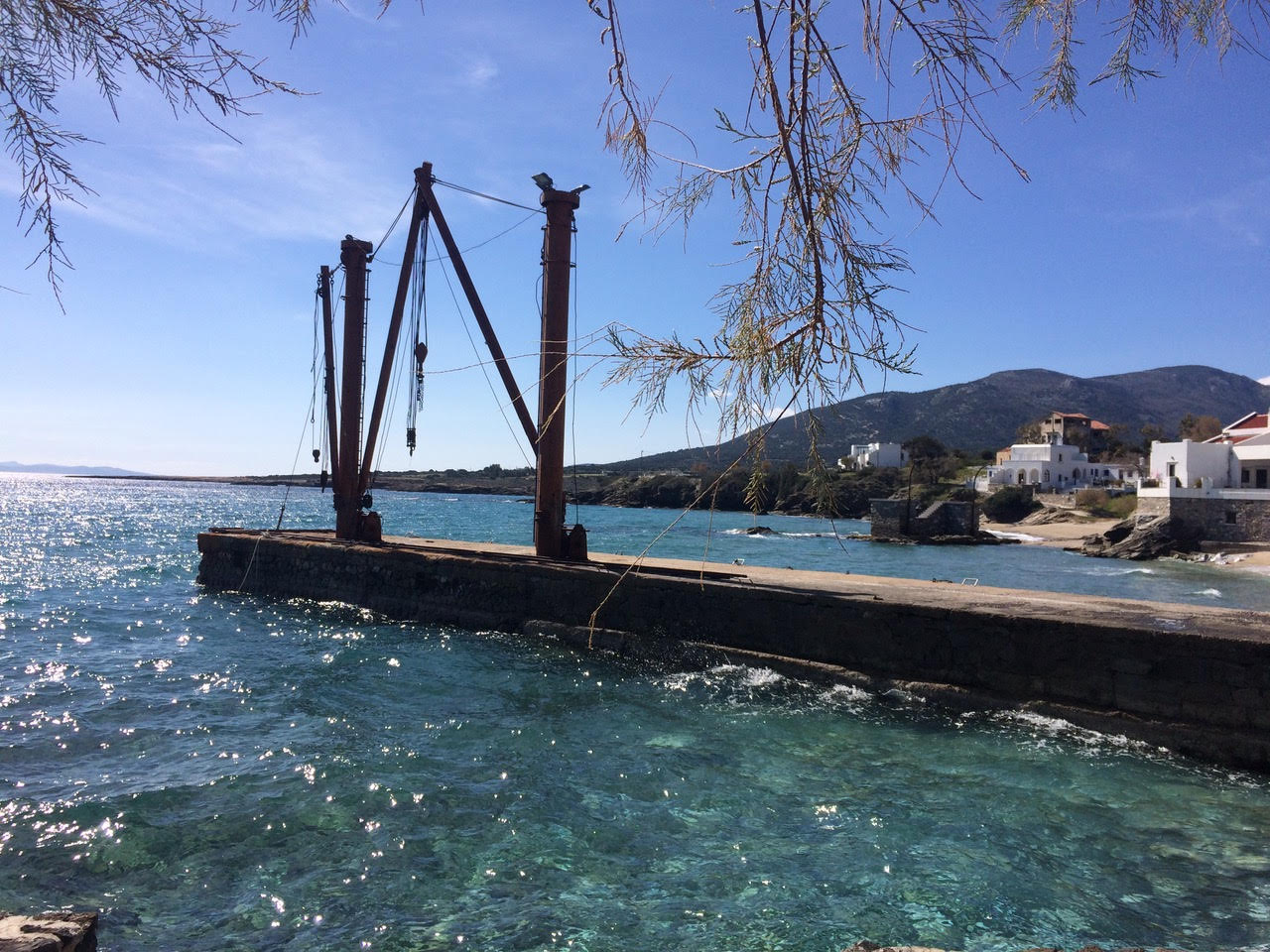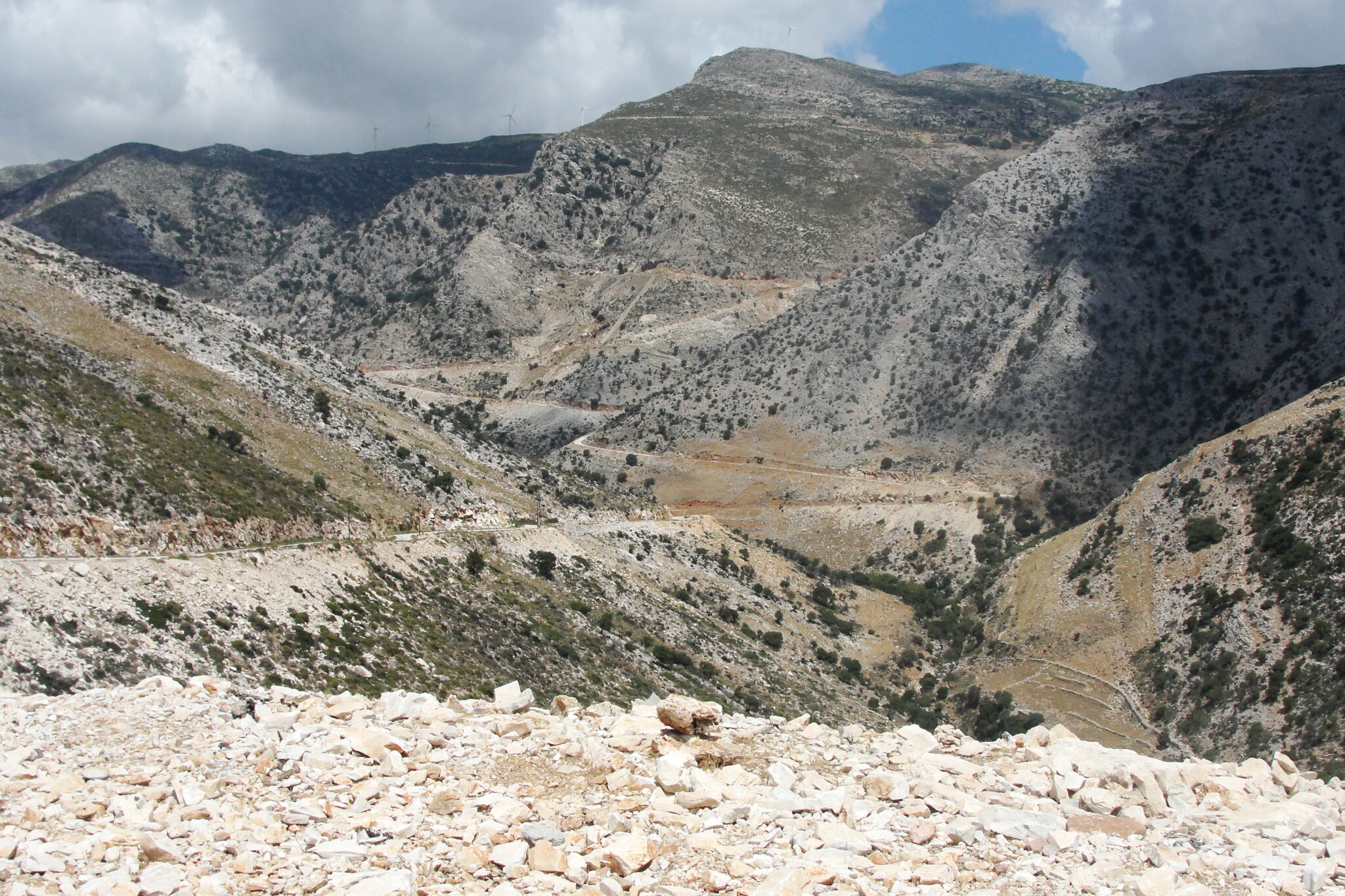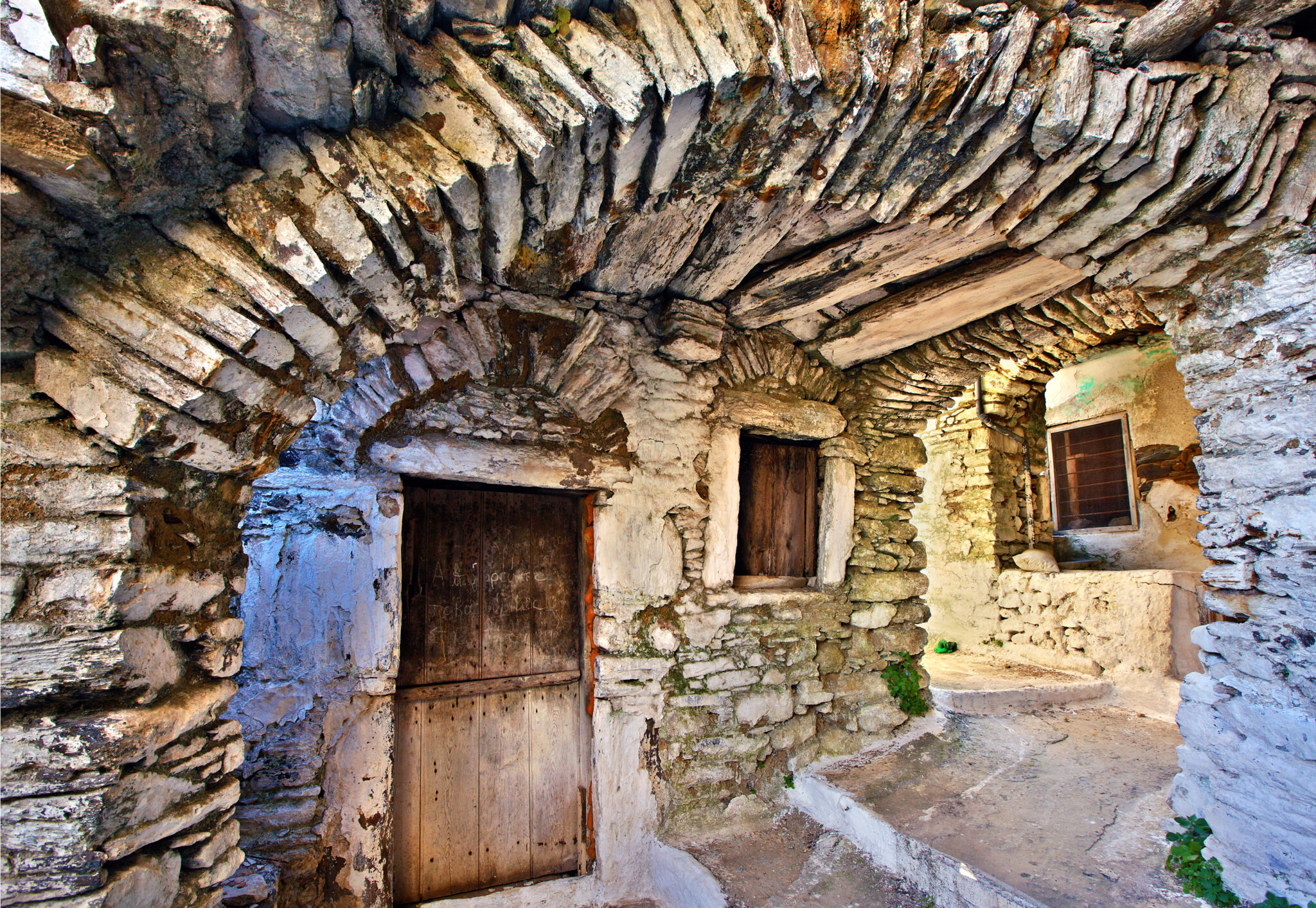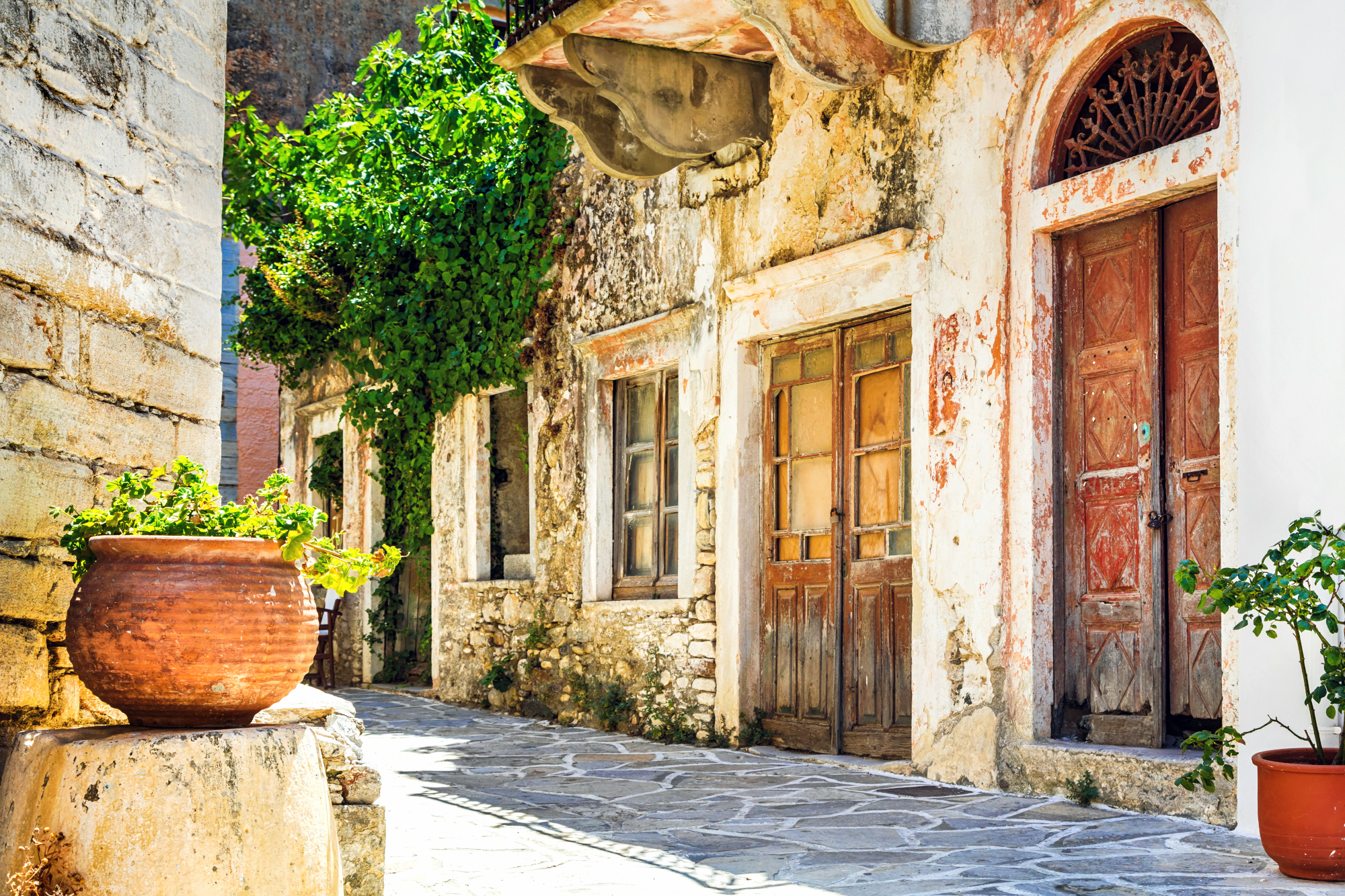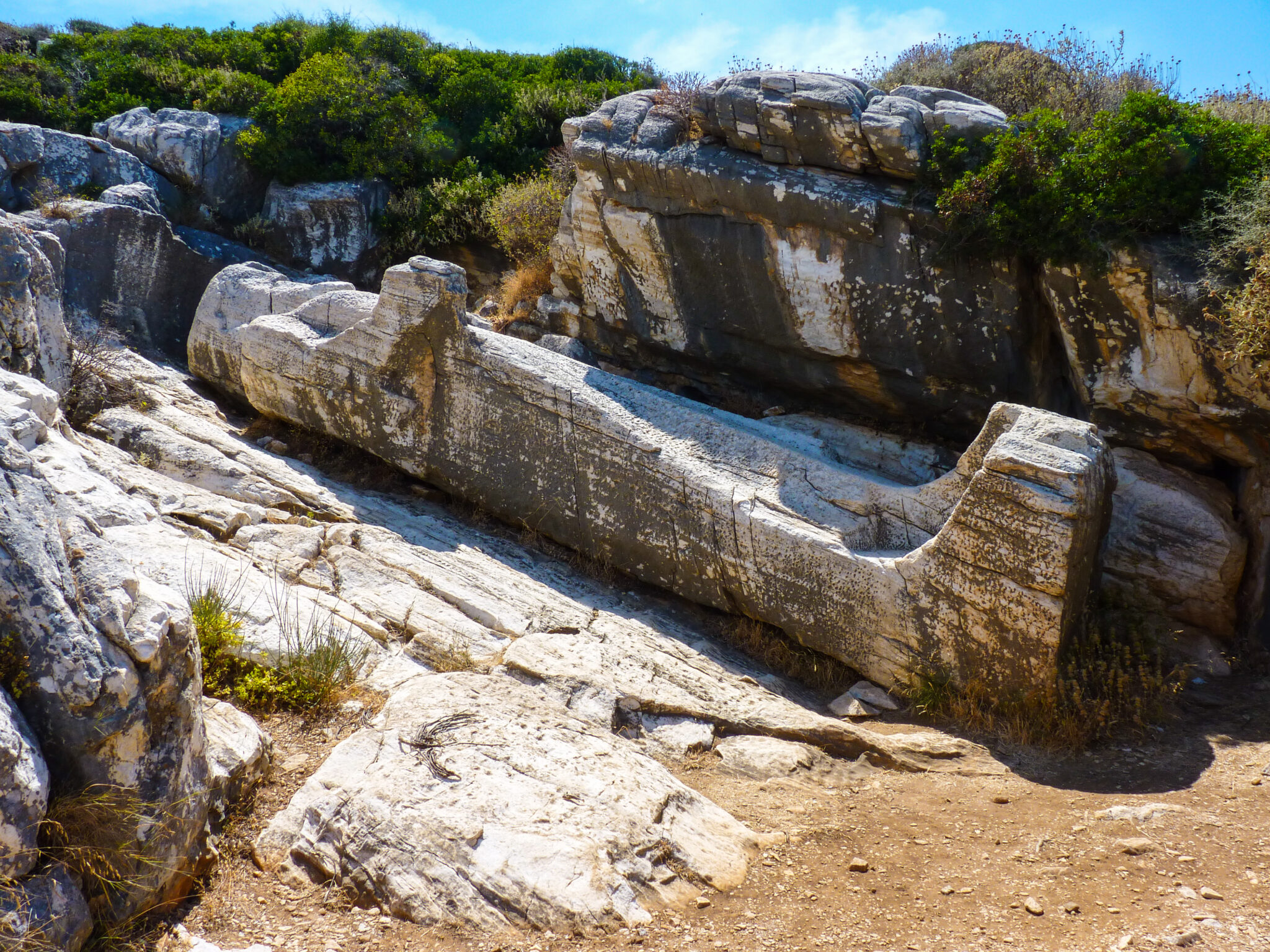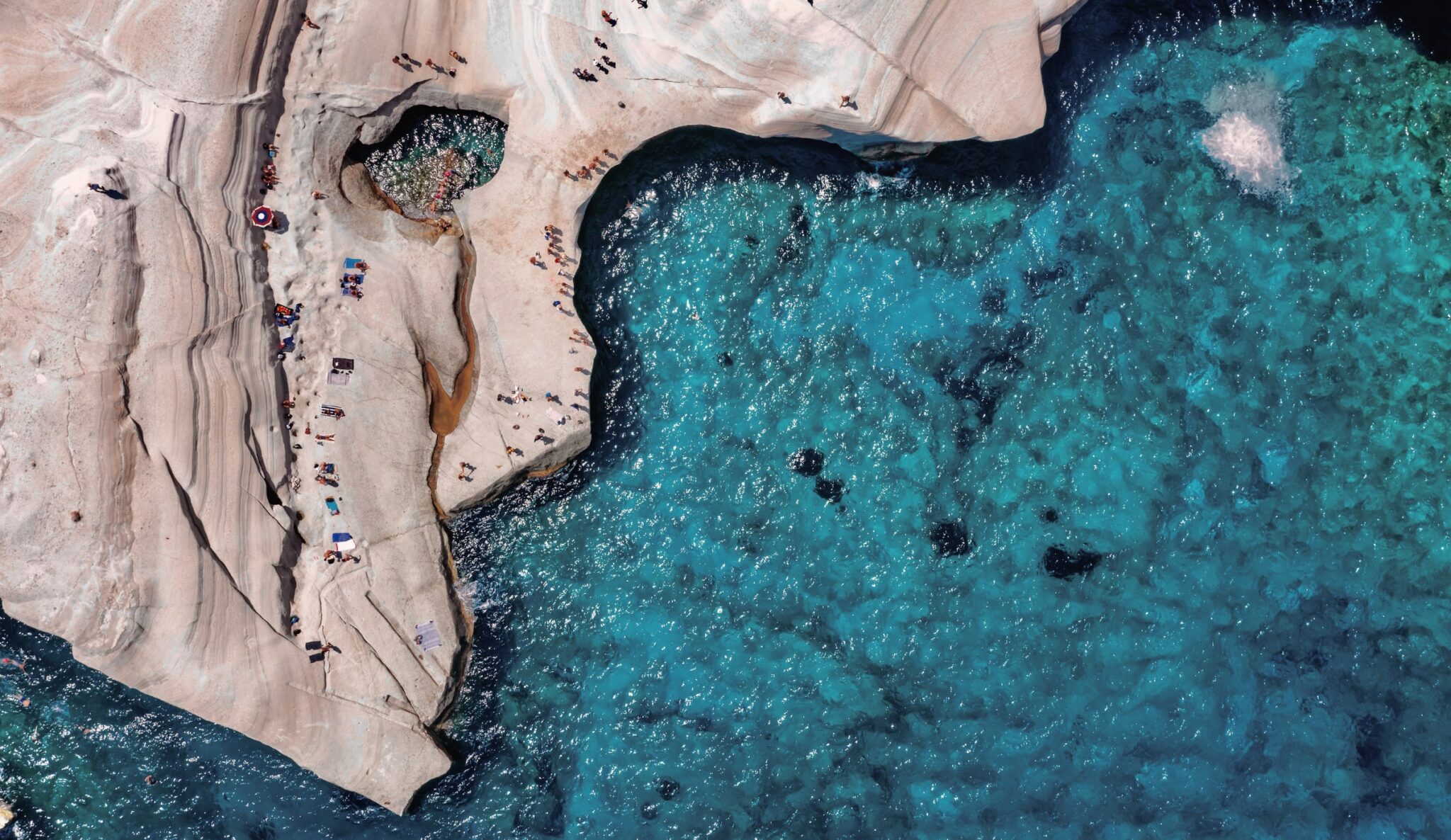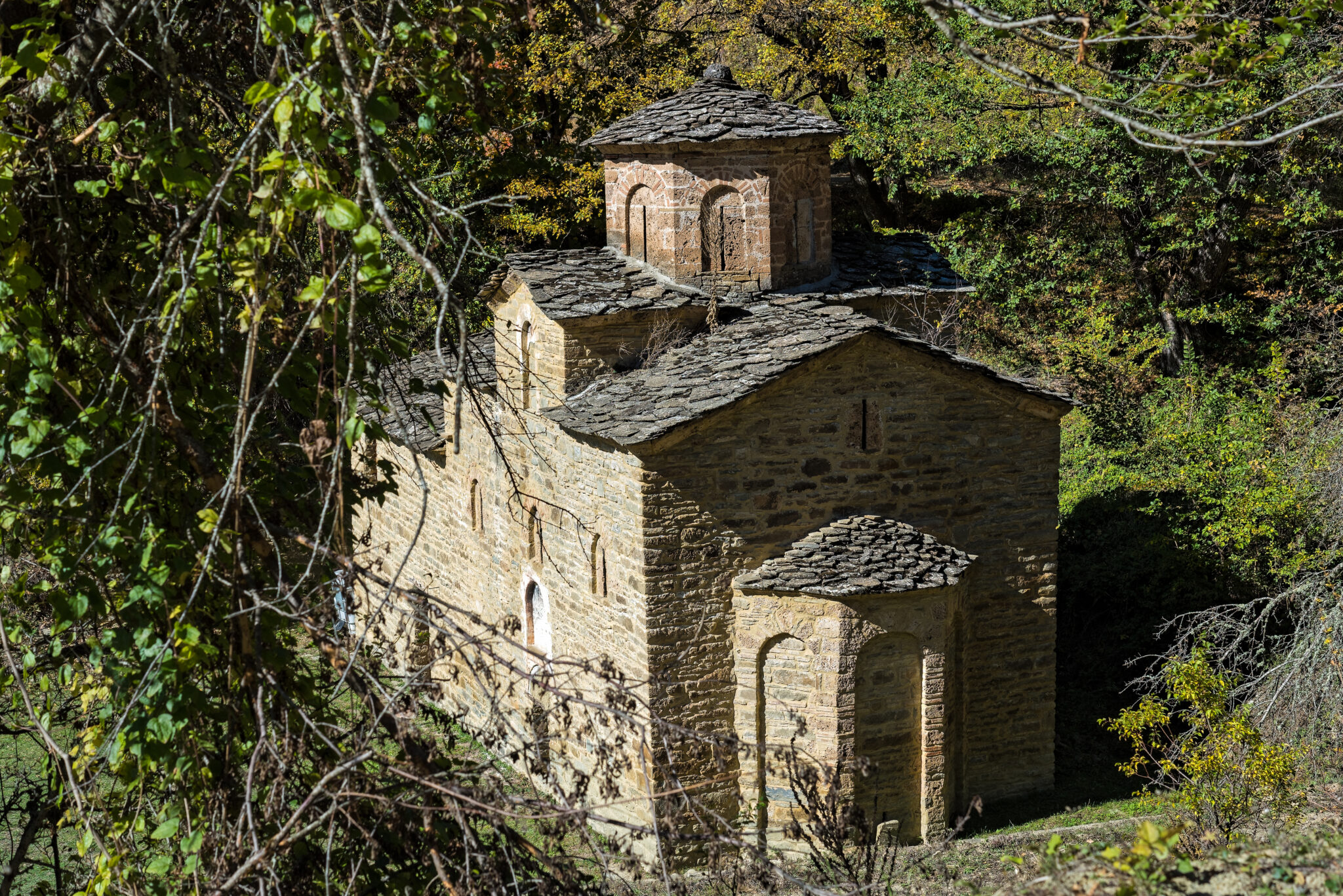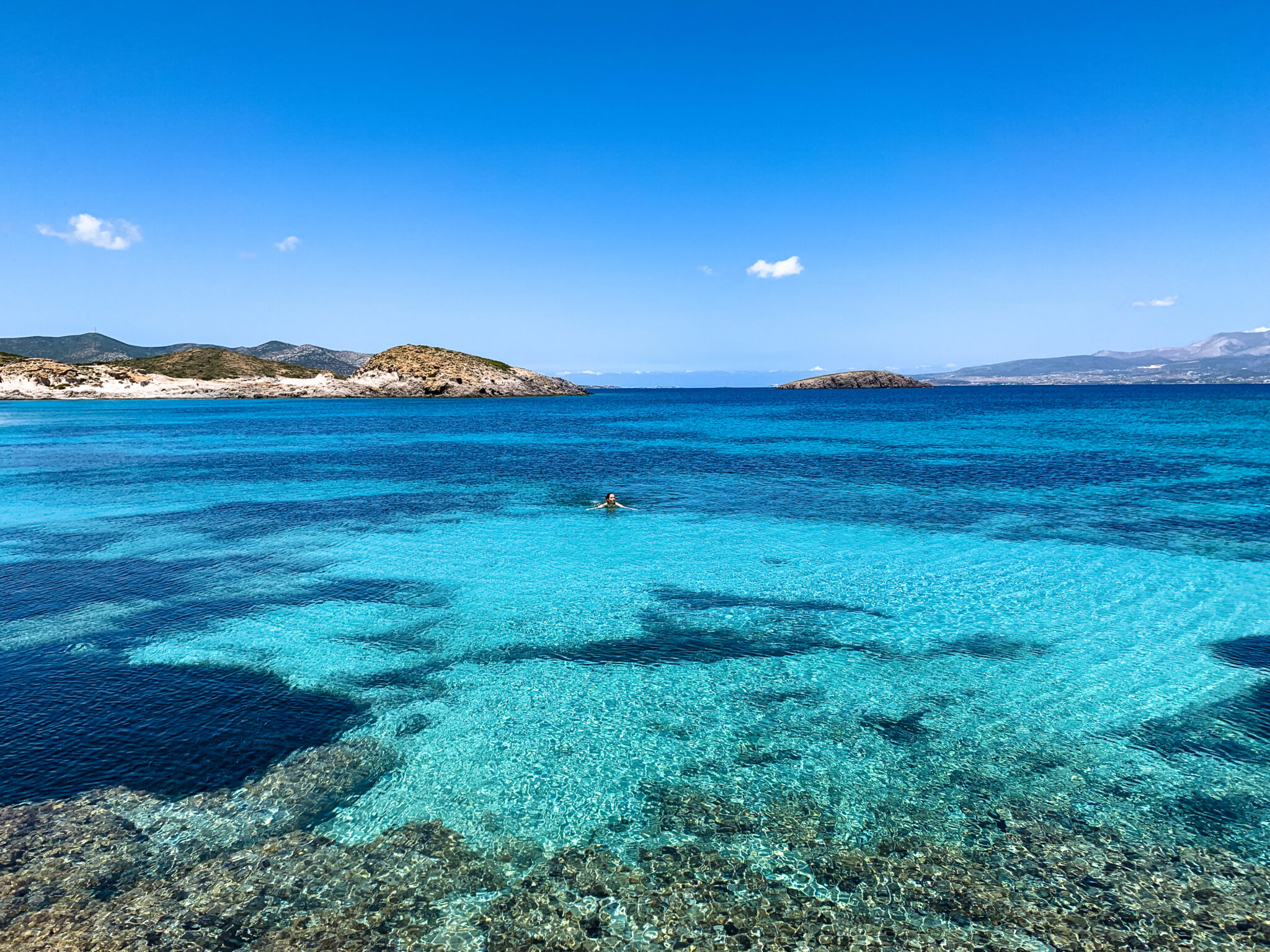Prehistoric ruins, ancient temples, Byzantine churches, Venetian castles, and fascinating museums abound in Naxos Town and the lush hinterland peppered with villages. The sheer volume of attractions, which span across history, is such that numerous visits are needed to truly appreciate it all. For now, we’ll spotlight just a few.
The Castle and the Portara
The best-known attractions in the Town are the castle of Naxos and the much-photographed Portara. Within the Town’s harbour, on a little islet, the chapel of Panagia Myrtidiotissa is set.
The Portara
Believed by archaeologists to be the grand entrance of the Temple of Apollo, the Portara was initiated between 530-524 B.C. by Lygdamis, the tyrant of Naxos. The temple was mysteriously dismantled before its completion and was never rebuilt. The monument site bears the distinct traces of the temple’s foundations, fragmented marbles, and the base of the surrounding colonnade.
The Castle of Naxos
The castle came to be when the Venetians landed on the island and Marco Sanudo established the Duchy of the Aegean (or Archipelago) in 1207. Interestingly, the tower was one of the first buildings to repurpose material from the ancient acropolis. Later, Latin nobles took up residence in the castle. This is the only Venetian castle in Greece that has been continuously inhabited since its construction. The castle originally had three entrances: the Trani Porta, the Paraporti, and the Piso Paraporti. The latter no longer stands.
Attractions
The Crispi Tower or Glezos Tower: This was the residence of the Dukes of the Crispi family, who would keep an eye on the sea from the rooftop. The defence of the Trani Porta, located directly below, was coordinated from this tower. The building has been beautifully restored.
The Catholic Metropolis: Established during the early years of the Venetian rule (13th century), it is the most prominent church of the castle. One of its notable features is the floor, decorated with marble reliefs that represent the heraldic symbols of the Dukes of Naxos.
The Orthodox Church of Theoskepasti: Notable for being the oldest monument in the castle (9th or 10th century), it predates the Venetians’ arrival and houses intriguing icons.
The Sanudo Chapel (also known as Capella Casaza): This is one of Naxos’s most significant monuments and was likely the chapel built by Marco Sanudo for worship in the 13th or 14th century. Over the years, it became the chapel for all the Dukes of Naxos. It is dedicated to the Immaculate Conception of the Virgin.
The Jesuit School: Set up by the Society of Jesuits in 1627, the school was eventually transformed by the Salesian monks into the well-known French Trade School of Naxos. Nikos Kazantzakis, a former student, referred to it as “…the renowned French School of the Francopapas…” in 1897 when he attended. The school closed its doors in 1927. One of the rooms of this monument temporarily serves as the Archaeological Museum.
The Ursuline Monastery: Officially opened in 1739, it was a school designed to mirror the Ursuline Monastery of Paris. For an extended period, it was regarded as one of Greece’s premier educational establishments and one of the finest schools in the Eastern Mediterranean.
The Streets of Bourgos and the Market
These areas, found to the north of the castle, were home to the Greeks, whilst the Catholics of Chora and the feudal lords inhabited the castle. When wandering the streets of Bourgos, you’ll stumble upon historical churches such as The Transfiguration, Saint Paraskevi, and Saint Demetrius. You’ll also come across quaint shops selling jewellery and art, alongside bars, restaurants, cafes, and traditional taverns with inviting courtyards. If you head northeast, you’ll traverse some tranquil lanes before making your way up Apollonos and Velten Streets to reach the castle. If you let the scent of the sea’s iodine guide you, you’ll find yourself in Mitropoleos Square and the archaeological site found there.
Naxos: A Town Bursting with Energy
With a wide range of attractions, shopping experiences, culinary treasures, nightlife, vacation homes, hotels, and boutique accommodations – Naxos Town is a vibrant hub that you’ll savour throughout your island getaway. Cafes, bakeries, and restaurants serving dishes made from the famously fresh local produce, along with a selection of international cuisines, line the waterfront and serpentine alleys. Many of them still preserve the island’s style. Stores of all kinds are concentrated around A. Protopapadaki, S. Papavasileiou, and their intersecting streets. A leisurely walk will lead you to the extensive organised beach of Saint George, lined with beach bars and a wide variety of restaurants.
The Cave of Za
As implied by its name, the cave is tucked into the slopes of Mount Za, the Cyclades‘ highest peak. The cave houses large chambers spanning up to 11 metres. Its interior design is rich, characterised by impressive stalactites, stalagmites, and rock formations. Excavations conducted in 1985-86 and 1994 revealed a trove of artefacts spanning from the Neolithic to Classical and Roman periods. The cave is linked with the worship of Zeus. Legend has it that Zeus spent his childhood here and received the thunderbolt from an eagle. Entry to the cave is at one’s own risk, and a powerful torch is essential. A trail leads to the peak of Za (approximately 1 hour’s hike).
The Towers of Naxos
Around 30 towers built by the Venetians from 1600 onwards remain intact on Naxos. They were primarily erected by feudal lords who exploited the wealth of the estates they held, using the towers as their bases. This explains why most of the towers are situated adjacent to the island’s most fertile and profitable lands. The towers cast a strict and imposing figure, complete with ramparts, battlements, arrow slits, large doors, and small windows.
Bazeos Tower
Positioned outside Sagri, it’s notable for its architectural style and exemplary restoration. The foundation stone was laid circa 1600, but it took its current fortified form in 1789. Initially housing the Monastery of the Holy Cross, it was later transferred to the Greek state, then sold to the Bazeos or Bassegio family. Each summer, it hosts one of the Cyclades’ most noteworthy cultural events – the Naxos Festival.
The Sanctuary of Yria
Just south of Chora, the Yria site has been a sanctuary of Naxos city since the 14th century BC, with operations lasting until the time of Roman rule. Initially, it was dedicated to Dionysus and possibly a female deity. It has seen four successive shrines over the centuries, and the restored one that stands today is from the archaic period (580 BC). Here, the island intertwines with the myth of Ariadne, claimed by Dionysus from Theseus when a raging sea forced them to seek refuge on Naxos. Dionysus married Ariadne, taking her first to Mount Koronos on Naxos, and later to Olympus.
The Temple of Demeter at Gyroula
Set amongst the fertile valley south of the village of Sagri, the Temple of Demeter at Gyroula stands as a testament to the region’s ancient worship of chthonic deities, Demeter and Kore-Persephone, sought for earth’s fertility. Around 530 BC, an impressive all-marble temple was erected, possibly in dedication to Demeter and Apollo. Many architectural fragments remain, showcasing the significance of this monument as a representation of early classical architecture. The site later saw the establishment of a three-aisled basilica in the Early Christian period (5th – 6th centuries), abandoned by the 8th century. Today, the area houses a museum collection featuring finds and architectural fragments.
Apeiranthos (Aperathou)
This village, famed for maintaining its traditional architecture and cleanliness amidst tourist development, is a true gem. Apeiranthos keeps alive customs, traditions, values, and practices with remarkable authenticity. As you wander the cobbled streets, admire the 17th-century Tower of Bardani, the restored Tower of Zevgoli, and the 18th-century Church of Panagia Apeiranthitissa. You’ll also discover four intriguing museums: the Archaeological, the Folklore, the Natural History, and the Geological. Don’t miss the chance to try Apeiranthian cuisine, and witness the local women’s long-engaged weaving.
The Emerald Mines of Naxos
Despite being declared preservable by the Ministry of Culture, the emerald mines of Naxos still wait to be turned into a geological park. Naxos was once Europe’s only region producing emeralds, with deposits in its northeast mountainous area, around the villages of Apeiranthos and Koronos. A significant project was the aerial railway, built between 1926 and 1929, to transport emeralds from the mines to Moutsouna for loading onto ships. This railway, among the few remaining in Greece, ceased operation in 1978.
Koronos
Koronos, one of the largest and oldest mountain villages on the island, owes much of its economy to emerald mining. With traditional architecture and surrounding natural beauty, it presents a picturesque scene. Here you can explore stone-paved alleys, stairs, terraces, and arches. The neighbourhood of Anegyrida is particularly captivating.
Nikos Kazantzakis in the Egares of Naxos
Just seven kilometres from Naxos Chora, you find Egares. Famed writer Nikos Kazantzakis, while studying at the Jesuit School in Naxos castle in 1897, resided here. In his “Report to Greco”, he described the island as a paradise on Earth.
Byzantine Monuments in Tragea
Tragea, a fertile plain home to twelve villages, houses approximately 30 of the Aegean’s most significant Byzantine churches, preserving Byzantine frescoes from the 6th to the 15th centuries. This region is often referred to as the “Mistras of Naxos“. Some of the key monuments include: Panagia Drosiani, one of the oldest and most prominent churches on Naxos, Panagia Protothroni in Halki (6th-7th centuries), Saint George Diasoritis with its esteemed frescoes, the earliest of which date back to the 11th century, and others spanning the 12th and 13th centuries.
Equally important is the Byzantine Panagia Damiothissa, Saint John in Kerami (13th century), and the Holy Apostles Metochiou, a Byzantine temple of substantial architectural merit: it’s the only one on Naxos with a two-story structure (presumably a side chapel). Frescoes from the 12th or 13th century have been preserved, discovered beneath the lime.
Halki
In the heart of the fertile plain of Tragea, you’ll find this elegant settlement with its neoclassical houses. As you wander, you’ll come across the church of Panagia Protothroni and the Barotsi-Gratsia tower, built in the early 17th century by the Barotsi family. You’ll find shops, cafes, restaurants, galleries, and the historic Vallindra distillery, where you can sample the renowned Naxiot citron, distilled from citron leaves. In the village square, you can take a break for coffee, desserts, and snacks.
The White Marble Quarries and the Kouroi of Naxos
Naxos’ marble, especially from the western part of the island, has been known since ancient times to rival that of Paros in quality. Near the ancient quarries, colossal half-finished kouroi statues lie abandoned, likely because they broke during transportation. These remarkable remnants from antiquity give a glimpse into the island’s rich cultural heritage.
Apalirou Castle
Constructed in the early Byzantine period, the castle of Apalirou likely had fortifications from ancient times. A significant portion of the castle’s robust walls, including some towers, ramparts, and cisterns, still stand. Visitors can enjoy a unique experience with astonishing views towards the southern side of Naxos.
Island Hopping in the Lesser Cyclades
From the port of Naxos, travellers can embark on island hopping in the Lesser Cyclades, visiting the beautiful islands of Iraklia, Schoinoussa, Donousa, and Koufonisia. They make for ideal destinations for those seeking alternative and quieter holidays, except during the peak tourist season when they become vibrant with people.
Read also:



